Telesat Bundle
What Drives Telesat's Strategy?
Understanding a company's core principles is key to evaluating its potential. Delving into the Telesat SWOT Analysis is a great start. But what truly shapes Telesat's journey in the dynamic satellite communications sector?
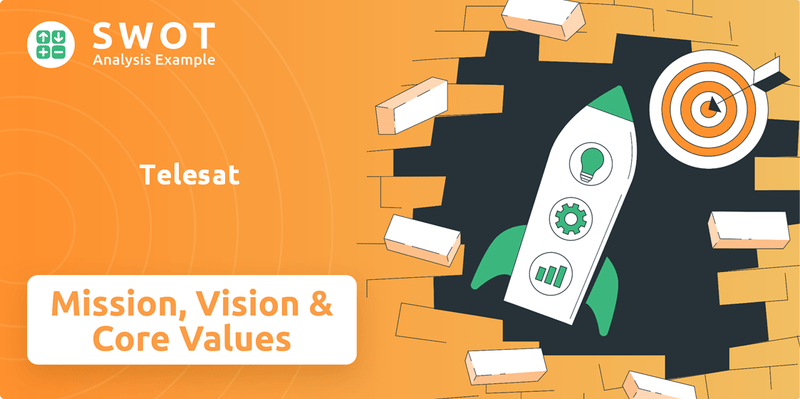
This exploration unveils the Telesat mission, Telesat vision, and Telesat core values, providing a crucial framework for understanding its strategic direction and commitment to innovation. As Telesat navigates the complexities of the satellite industry, these elements are paramount in shaping its corporate identity and guiding its ambitious initiatives, including the Lightspeed LEO constellation. Examining these principles offers insights into Telesat's vision for the future of space and its impact on global connectivity.
Key Takeaways
- Telesat's mission, vision, and values are critical for success, especially with Lightspeed.
- Customer focus, engineering excellence, and a forward-thinking approach are key values.
- These principles guide strategy, attract talent, and build strong partnerships.
- A strong corporate purpose is essential in the dynamic satellite industry.
- Telesat aims to bridge the digital divide with innovative connectivity.
Mission: What is Telesat Mission Statement?
Telesat's mission is to provide critical connectivity solutions globally, leveraging satellite technology to meet the evolving needs of businesses, governments, and communities.
Let's delve into the specifics of Telesat's mission.
At its heart, the Telesat company mission revolves around delivering essential connectivity. This involves a commitment to ensuring reliable and far-reaching communication capabilities, a critical service in today's interconnected world. Telesat's actions consistently reflect this focus.
Telesat's existing geostationary (GEO) satellite services are a prime example of its mission in action. These satellites provide essential services like broadband internet, video distribution, and data communications. They currently maintain a contractual backlog of approximately $1.0 billion, showcasing their ongoing significance in delivering connectivity solutions.
The development of the Telesat Lightspeed constellation further exemplifies Telesat's mission. This Low Earth Orbit (LEO) initiative aims to provide ubiquitous, high-capacity, secure, and resilient links with fiber-like speeds. The Lightspeed constellation has a LEO backlog of nearly $1.1 billion, indicating strong demand for its advanced services.
The Telesat mission is fundamentally customer-centric. The company focuses on meeting the connectivity needs of diverse user groups, including enterprises, governments, and communities, especially in remote areas like the Arctic. This focus ensures that Telesat's services directly address real-world communication challenges.
Innovation is a crucial aspect of the Telesat mission. The Lightspeed constellation represents a forward-looking approach to addressing future demands and technological advancements. This commitment to innovation ensures that Telesat remains at the forefront of the satellite communications industry.
Telesat's mission significantly impacts the satellite communications industry. By providing reliable and high-capacity connectivity, Telesat enables various sectors to thrive, from businesses and governments to communities in underserved areas. The company's focus on innovation and customer needs positions it as a key player in the evolution of global communications.
In summary, the
Telesat SWOT Analysis
- Complete SWOT Breakdown
- Fully Customizable
- Editable in Excel & Word
- Professional Formatting
- Investor-Ready Format
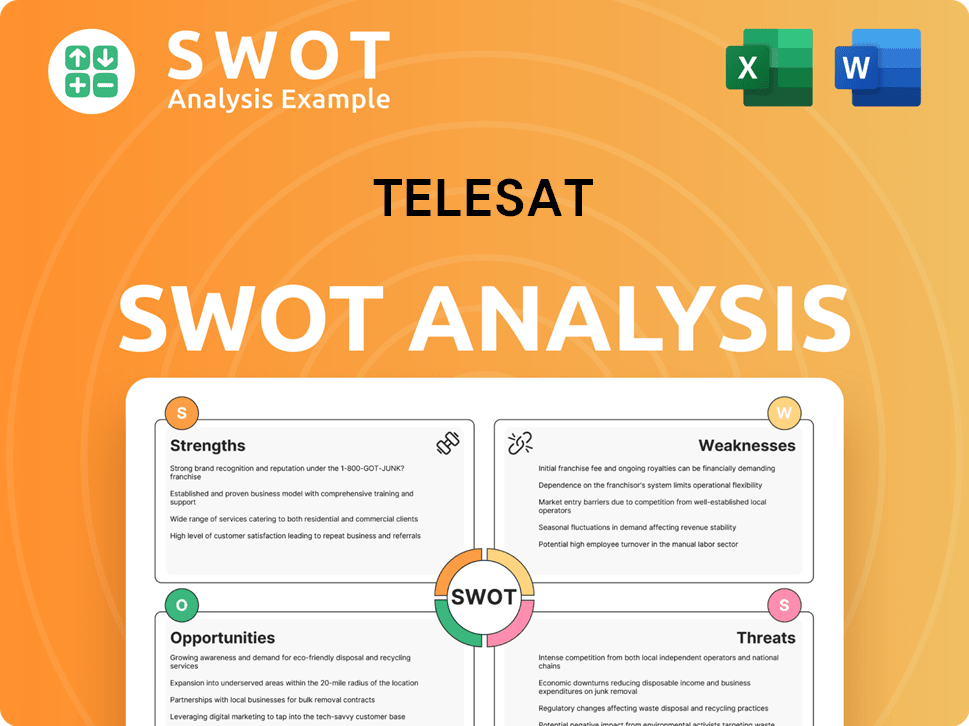
Vision: What is Telesat Vision Statement?
Telesat's vision is to redefine global satellite connectivity by deploying and operating its Lightspeed LEO constellation, providing ubiquitous, affordable, high-capacity, secure, and resilient connectivity with fiber-like speeds.
Let's delve into the intricacies of Telesat's vision, exploring its ambitions and the challenges it faces.
At the heart of the Telesat vision lies the Lightspeed LEO (Low Earth Orbit) constellation. This project aims to revolutionize satellite communications by offering significantly improved performance compared to traditional GEO (Geostationary Orbit) satellites. Lightspeed promises lower latency, higher bandwidth, and enhanced security, targeting a wide range of customers.
The scope of Telesat's vision is undeniably global. The company intends to provide connectivity solutions across the world, addressing the growing demand for high-speed internet access in underserved areas and offering enhanced services to existing markets. This global reach is crucial for the company's long-term success and its ambition to become a leader in the satellite industry.
Telesat is targeting key markets, including enterprise, government, maritime, and aeronautical sectors. These sectors have specific needs for reliable and high-bandwidth connectivity, and Lightspeed is designed to meet these demands. Securing contracts and partnerships within these sectors is critical to realizing the company's vision.
The Telesat company has secured significant financial backing, including $2.54 billion in loan financing from the Canadian and Quebec governments. This governmental support underscores the strategic importance of the Lightspeed project and provides a degree of confidence in its viability. This financial commitment is a crucial element in the realization of the Telesat mission.
Strategic partnerships are vital for Telesat's vision. Collaborations with companies such as Viasat, Orange, and Arabsat for Lightspeed services demonstrate market interest and potential for widespread adoption. These partnerships are crucial for expanding market reach and validating the commercial viability of the Lightspeed constellation. These partnerships are explored in more detail in Revenue Streams & Business Model of Telesat.
Despite the ambition and support, the project faces challenges. The Telesat vision requires substantial capital investment, and the project has experienced delays. The satellite industry is highly competitive, and successfully launching and operating the Lightspeed constellation is a complex undertaking. Overcoming these challenges is essential for the company to achieve its goals.
In conclusion, Telesat's vision is ambitious and future-oriented. While the company has made significant strides, the successful deployment of Lightspeed and its ability to capture market share will be critical to realizing this vision and establishing Telesat as a leader in the evolving satellite communications landscape. As of late 2024, the project is still in progress, and its ultimate success will depend on the company's ability to navigate the challenges ahead and capitalize on the growing demand for global connectivity.
Telesat PESTLE Analysis
- Covers All 6 PESTLE Categories
- No Research Needed – Save Hours of Work
- Built by Experts, Trusted by Consultants
- Instant Download, Ready to Use
- 100% Editable, Fully Customizable
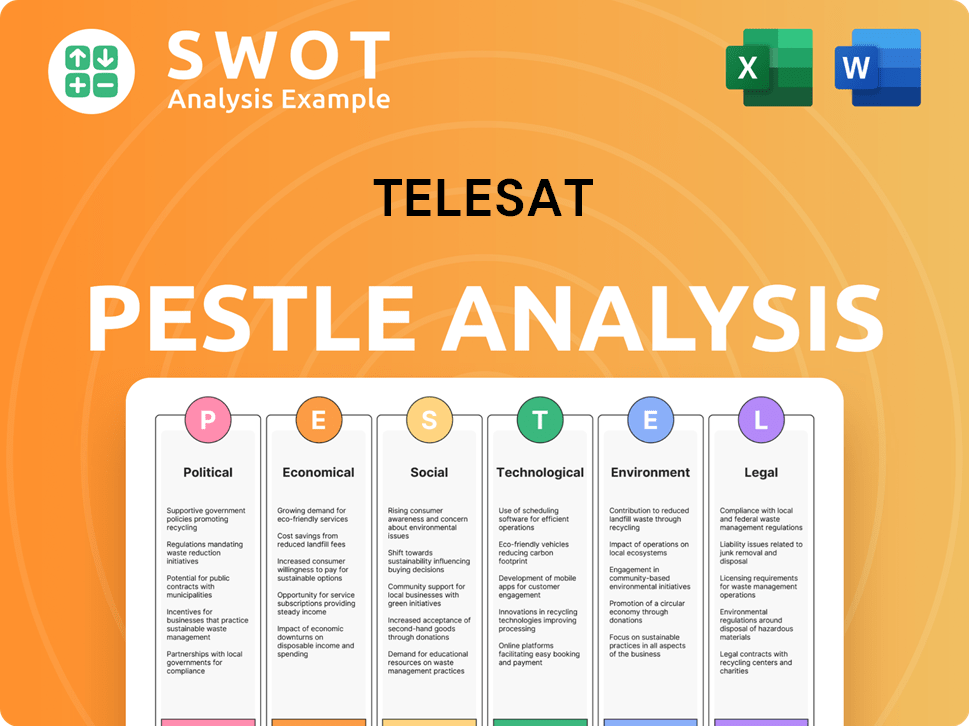
Values: What is Telesat Core Values Statement?
Understanding the core values of a company provides critical insights into its operational principles and strategic direction. For Telesat, its core values are the bedrock upon which it builds its relationships, innovations, and future endeavors in the dynamic field of satellite communications.
Telesat places a strong emphasis on being customer-centric, working closely with its clients to shape offerings and expand market reach. This is evident in its collaborative partnerships, such as the integration of Lightspeed services with companies like Viasat, Orange, and Arabsat, to provide tailored solutions for diverse sectors. This approach has helped Telesat secure significant contracts, with the company's backlog reaching $1.8 billion as of the latest financial reports, demonstrating the effectiveness of its customer-focused strategy.
Telesat is driven by a legacy of engineering excellence, which enables it to design innovative and robust satellite network architectures. The Telesat Lightspeed constellation exemplifies this, with advanced capabilities designed to meet demanding communication requirements. The company's investment in research and development consistently hovers around 10-12% of its annual revenue, reflecting its commitment to maintaining a competitive edge through technological innovation.
As a long-standing player in the satellite communications industry, Telesat leverages its decades of experience to lead and disrupt the market. This established presence, from its GEO satellite fleet to the development of Lightspeed, positions Telesat as a reliable partner. Its longevity and proven track record are significant differentiators, especially when compared to newer entrants in the LEO space, contributing to its strong reputation and market position.
Telesat balances its ambitious future projects, like Lightspeed, with a commitment to addressing the current needs of its customers. This forward-thinking approach allows Telesat to stay at the forefront of satellite technology and connectivity solutions. This dual focus is crucial for maintaining its competitive edge and ensuring sustainable growth in the rapidly evolving satellite communications landscape.
These core values of Telesat—customer centricity, engineering excellence, established reliability, and a future-focused approach—are fundamental to its operations and strategic decision-making. These principles guide the Telesat company in its mission to provide innovative satellite solutions. Understanding these values provides a solid foundation for analyzing the Telesat mission and Telesat vision, and how they shape the company's strategies. For a deeper understanding of the competitive environment in which Telesat operates, consider exploring the Competitors Landscape of Telesat. The next chapter will delve into how the Telesat mission and Telesat vision influence the company's strategic decisions.
How Mission & Vision Influence Telesat Business?
The Telesat mission and Telesat vision are pivotal in shaping the company's strategic direction, especially concerning its significant investments in advanced satellite technology. This influence is most evident in the company's commitment to its Lightspeed constellation, a project directly aligned with its forward-looking goals.
The Telesat vision of redefining global satellite connectivity with fiber-like speeds is the driving force behind the Lightspeed constellation. This vision is reflected in the substantial capital expenditures allocated to the project.
- Projected capital expenditures for 2025 are between $900 million and $1.1 billion, primarily for Lightspeed.
- The Lightspeed project is designed to provide high-capacity, low-latency connectivity globally.
- This strategic focus underscores Telesat's commitment to innovation in satellite communications.
Telesat's mission and vision have been instrumental in securing crucial funding and forming strategic partnerships. These collaborations are essential for the successful deployment and operation of the Lightspeed constellation.
The company's alignment with governmental objectives has been key to securing funding. This alignment demonstrates the impact of the Telesat mission on broader societal goals.
Partnerships with major players like Viasat, Orange, and Arabsat expand market reach and validate the capabilities of the Lightspeed constellation. These partnerships are a direct result of the Telesat vision to provide ubiquitous, high-capacity connectivity.
Telesat's focus on the government market, especially in areas like the Arctic, aligns with its mission to provide critical connectivity and support national security objectives. This is a strategic decision influenced by the company's core values.
The growing LEO backlog is a key indicator of the increasing customer commitment to the Lightspeed vision. This growth demonstrates the market's acceptance of Telesat's strategic direction.
Leadership plays a crucial role in reinforcing these statements. CEO Dan Goldberg's consistent emphasis on the Lightspeed program underscores the influence of the vision on their outlook and strategy.
In conclusion, the Telesat mission and Telesat vision are not merely statements but the very foundation of the company's strategic planning and execution. The commitment to Lightspeed, the securing of funding, and the formation of strategic partnerships all reflect a clear alignment with the company’s core objectives. To delve deeper into the foundational elements of Telesat, read more about Mission, Vision & Core Values of Telesat.
Telesat Business Model Canvas
- Complete 9-Block Business Model Canvas
- Effortlessly Communicate Your Business Strategy
- Investor-Ready BMC Format
- 100% Editable and Customizable
- Clear and Structured Layout
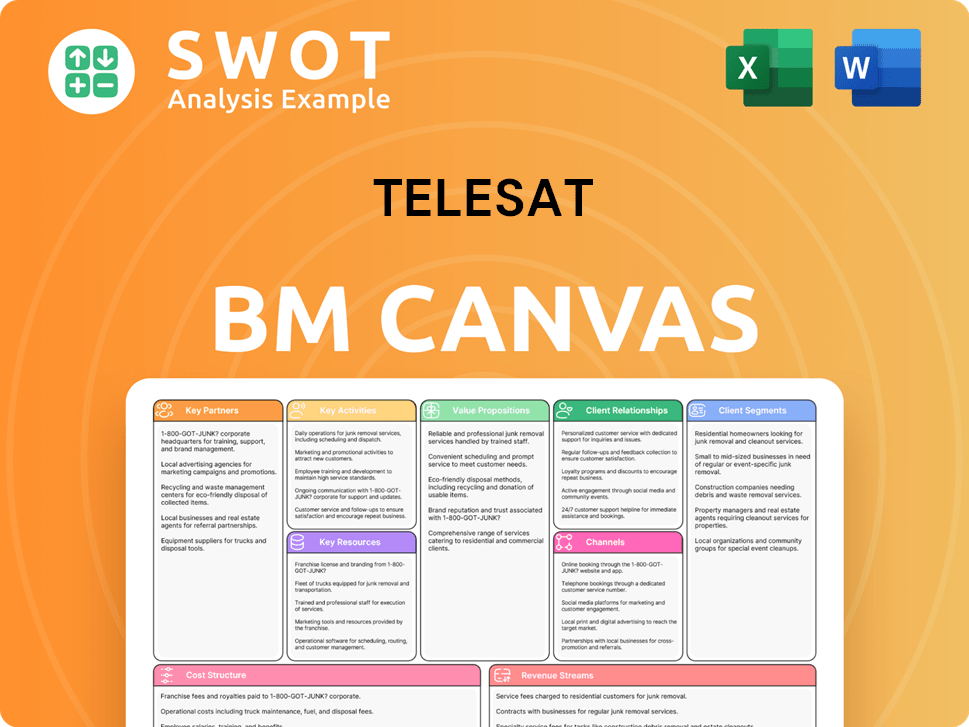
What Are Mission & Vision Improvements?
While Telesat's current strategic direction is clear, particularly with the Lightspeed constellation, refining its mission and vision statements can enhance clarity and adaptability. These improvements can strengthen external communication and position the company for long-term success in the dynamic satellite communications industry.
Explicitly stating a concise Telesat mission and Telesat vision on readily accessible corporate materials would improve external communication. This clarity helps stakeholders understand Telesat's goals and values, fostering trust and attracting investment. Currently, the satellite industry is projected to reach $368.6 billion by 2030, according to a report by Grand View Research, highlighting the importance of clear communication.
Integrating sustainability into Telesat's core values would resonate with environmentally conscious customers and investors. As the satellite industry grows, addressing space debris and environmental impact is crucial. A clear commitment could attract ESG-focused investors, a rapidly growing segment of the market. The global ESG investment market is projected to reach $50 trillion by 2025, according to Bloomberg Intelligence.
Articulating how Telesat's mission and Telesat vision address the increasing demand for direct-to-consumer satellite internet services could position the company for future opportunities. Even though the primary focus is on enterprise and government markets, acknowledging the broader market shifts is important. The direct-to-consumer satellite internet market is experiencing significant growth, with companies like Starlink increasing their subscriber base rapidly.
Strengthening the Telesat mission and vision by explicitly mentioning adaptability and the integration of emerging technologies ensures continued relevance and competitiveness. As advanced ground infrastructure and next-generation user terminals evolve, this focus is critical. For a deeper understanding of Telesat, you can explore its history in Brief History of Telesat.
How Does Telesat Implement Corporate Strategy?
Implementing a company's mission, vision, and core values is crucial for translating strategic intent into tangible results. This chapter examines how Telesat, a leading player in the satellite communications industry, is actively putting its guiding principles into action.
The primary vehicle for implementing the Telesat mission and vision is the Telesat Lightspeed constellation. This ambitious project represents a significant investment and a bold step towards achieving their long-term goals.
- Financial Commitment: Telesat is investing heavily in Lightspeed, with projected expenditures of $900 million to $1.1 billion in 2025. This demonstrates a strong commitment to their vision.
- Technical Milestones: The successful completion of the Preliminary Design Review for the spacecraft and ground segment in late 2024 showcases the technical progress aligned with their vision of an advanced LEO network.
- Strategic Focus: Lightspeed is designed to provide high-speed, low-latency broadband connectivity globally, directly supporting Telesat's mission of transforming global connectivity.
Leadership plays a critical role in ensuring the
Consistent Communication: CEO Dan Goldberg regularly communicates the strategic importance of Lightspeed to investors, partners, and the media, ensuring alignment and understanding.
Telesat actively communicates its mission, vision, and progress to stakeholders through various channels. This transparency builds trust and demonstrates their commitment to their stated goals.
Financial Reporting: Financial reports provide detailed information on the progress and investment in Lightspeed, offering transparency to investors. For example, the company's Q3 2024 report would detail the progress.
While specific formal programs may not be explicitly detailed, Telesat's actions demonstrate alignment with its core values. This is evident in their customer-centric approach and engineering-driven focus.
Customer-Centric Approach: Collaborative partnerships, like those with Viasat, Orange, and Arabsat, demonstrate a customer-centric approach to tailoring Lightspeed services for specific markets.
The success of Telesat's implementation strategy will be measured by the deployment and performance of Lightspeed, as well as its ability to secure commercial contracts. The company’s future hinges on the successful execution of its current plans.
Key Metrics: Key metrics include the number of satellites launched, the number of customer contracts secured, and the revenue generated by Lightspeed services. The company's stock performance will also be a key indicator.
Telesat Porter's Five Forces Analysis
- Covers All 5 Competitive Forces in Detail
- Structured for Consultants, Students, and Founders
- 100% Editable in Microsoft Word & Excel
- Instant Digital Download – Use Immediately
- Compatible with Mac & PC – Fully Unlocked
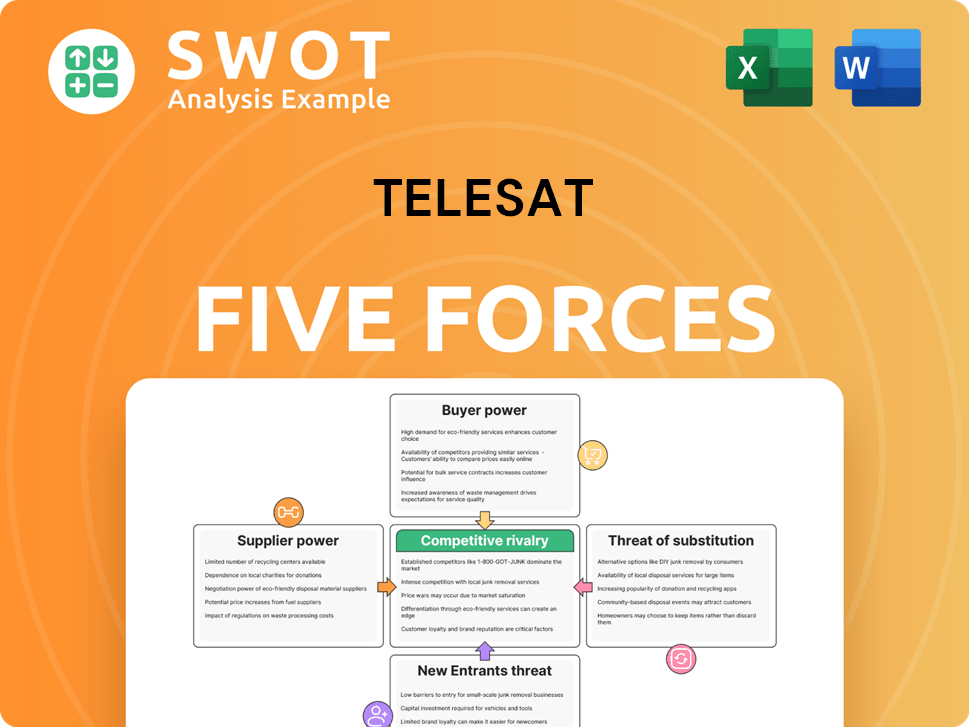
Related Blogs
- What are Mission Vision & Core Values of Telesat Company?
- What is Competitive Landscape of Telesat Company?
- What is Growth Strategy and Future Prospects of Telesat Company?
- How Does Telesat Company Work?
- What is Sales and Marketing Strategy of Telesat Company?
- Who Owns Telesat Company?
- What is Customer Demographics and Target Market of Telesat Company?
Disclaimer
All information, articles, and product details provided on this website are for general informational and educational purposes only. We do not claim any ownership over, nor do we intend to infringe upon, any trademarks, copyrights, logos, brand names, or other intellectual property mentioned or depicted on this site. Such intellectual property remains the property of its respective owners, and any references here are made solely for identification or informational purposes, without implying any affiliation, endorsement, or partnership.
We make no representations or warranties, express or implied, regarding the accuracy, completeness, or suitability of any content or products presented. Nothing on this website should be construed as legal, tax, investment, financial, medical, or other professional advice. In addition, no part of this site—including articles or product references—constitutes a solicitation, recommendation, endorsement, advertisement, or offer to buy or sell any securities, franchises, or other financial instruments, particularly in jurisdictions where such activity would be unlawful.
All content is of a general nature and may not address the specific circumstances of any individual or entity. It is not a substitute for professional advice or services. Any actions you take based on the information provided here are strictly at your own risk. You accept full responsibility for any decisions or outcomes arising from your use of this website and agree to release us from any liability in connection with your use of, or reliance upon, the content or products found herein.